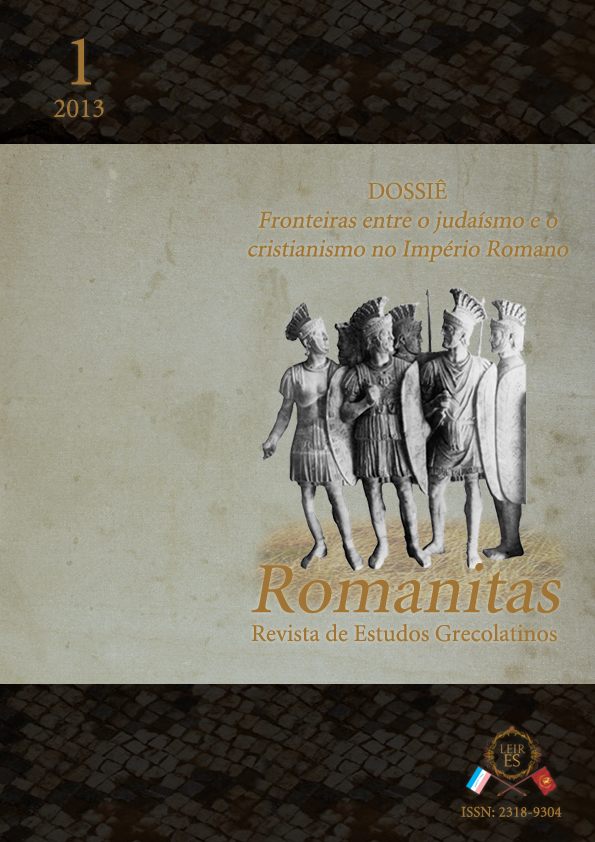História, historiografia e documento: o estudo sobre judeus e cristãos em Antioquia de Orontes (séc. IV d. C.)
DOI:
https://doi.org/10.17648/rom.v0i1.6255Palavras-chave:
Antiguidade Tardia, Cristianismo, Judaísmo, Antioquia -de-OrontesResumo
A historiografia acerca das relações judaico‑cristãs no contexto da Antiguidade Tardia tem sido, recentemente, um lugar de importantes e vitais reflexões, apresentando uma mudança de perspectiva que questiona antigas concepções. No presente artigo, buscamos refletir sobre os debates oferecidos por essa nova tendência historiográfica, de modo que possamos compreender uma história particular das relações entre judeus e cristãos no espaço da cidade de Antioquia‑de‑Orontes, no contexto do século IV d. C. Para isso, recorreremos a uma abordagem específica, dando destaque ao âmbito da História Política e Cultural. Além disso, tratamos de algumas das fontes disponíveis para o estudo dessa temática.Downloads
Referências
Documentação primária impressa
JOHN CHRYSOSTOM. Discourses against judaizing Christians. In: HARKINS, P. W. Saint John Chrysostom: discourses against judaizing Christians. Washington: The Catholic University of America Press, 1999.
______. The Homilies on the statues to people of Antioch. In: SCHARFF, P. A select library of the Nicene and Post-Nicene Fathers of the Christian Church. Michigan: T&T Clark / WM. B. Eerdmans Publishing Company, 1996, v. IX, p. 315-514.
LIBANIUS. Letter 131. In: NORMAN, A. F. Libanius: autobiography and selected letters. Loeb Classical Library, n. 479,Cambridge/London: Harvard University Press, 1992, p. 261. v. II.
______. Oration XLVII: On protection systems. In: NORMAN, A. F. Libanius: selected orations, Loeb Classical Library, n. 452. Cambridge/London: Harvard University Press, 1977, p. 492 535. v. II.
______. Discours sur les patronages. In: HARMAND, L. Libanius: discours sur les patronages. Paris: Presses Universitaires de France, 1955.
______. Letter 914. In: STERN, M. Greek and Latin authors on Jews and Judaism. Jerusalem: The Israel Academy of Sciences and Humanities, 1980, v. 2, p. 589 590.
______. Letter 1097. In: STERN, M. Greek and Latin authors on Jews and Judaism. Jerusalem: The Israel Academy of Sciences and Humanities, 1980, v. 2, p. 594 5.
______. Letter 1251. In: STERN, M. Greek and Latin authors on Jews and Judaism. Jerusalem: The Israel Academy of Sciences and Humanities, 1980, v. 2, p. 598.
LINDER, A. The Jews in Roman imperial legislation. Detroit: Wayne State University Press, 1987.
MEEKS, W. A.; WILKEN, R. L. Archaeological sources. In: ______. Jews and Christians in Antioch in the first four centuries of the common Era. Missoula: Scholars Press/The Society of Biblical Literature, 1978.
Obras de apoio
BRANDBURY, S. Selected letters of Libanius: from age of Constantius and Julian. Liverpool: Liverpool University Press, 2004.
BROOTEN, B. The Jews of Ancient Antioch. In: KONDOLEON, C. Antioch: the lost ancient city. Oxford: Princeton University Press, 2000, p. 29 37.
CAMERON, A. The last pagans of Rome. Oxford: Oxford University Press, 2010.
CARLEBACH, E.; SCHACTER, J. J. New perspectives on Jewish Christian relations. Leiden: Brill, 2012.
DOWNEY, G. A history of Antioch in Syria: from Seleucus to the Arab conquest. Mansfield: Martino Publishing, 2009.
HARMAND, L. Le procès entre Libanius et ses travailleurs juifs. In: ______. Libanius: discours sur les patronages. Paris: Presses Universitaires de France, 1955, p. 185 203.
HOSANG, F. J. E. B. Establishing boundaries: Christian Jewish relations in early council. Texts and writings of the Church Fathers. Leiden: Brill, 2010.
JACOBS, A. S. Remains of the Jews: the holy land and Christian Empire in Late Antiquity. Stanford: Stanford University Press, 2004.
LINDER, A. The legal status of the Jews in the Roman Empire. In: KATZ, S. T. The Cambridge history of Judaism: the Late Roman Rabbinic period. Cambridge University Press, 2008, p. 128 173. v. 4.
MAXWELL, J. L. Christianization and communication in Late Antiquity: John Chrysostom and his congregation in Antioch. Cambridge: Cambridge University Press, 2006.
MAYER, W. The Homilies of St. John Chrysostom: provenance, reshaping the foundations. Roma : Pontificio Istituto Orientale, 2005.
MEEKS, W. A.; WILKEN, R. L. Jews and Christians in Antioch in the first four centuries of the Common Era. Missoula: Scholars Press/The Society of Biblical Literature, 1978.
NORMAN, A. F. Libanius: autobiography and selected letters. Cambridge/London: Harvard University Press, 1992. v 2.
REED, A. Y.; BECKER, A. H. Introduction: traditional models and new directions. In: ______. The ways that never parted: Jews and Christians in Late Antiquity and the Early Middle Ages. Tübingen: Mohr Siebeck, 2003, p. 1 34.
SCHREMER, A. Brothers Estranged: heresy, Christianity and Jewish identity in Late Antiquity. Oxford: Oxford University Press, 2010.
SILVA, G. V. da. Construindo fronteiras religiosas no Império Romano: João Crisóstomo e a polêmica com os judeus e judaizantes em Antioquia. Anais do XXV Simpósio Nacional de História, Fortaleza, p. 1 8, 2009.
______. Sementes da intolerância na Antiguidade Tardia: João Crisóstomo e o confronto com os judeus de Antioquia. Dimensões, vol. 25, p. 63 81, 2010.
STROUMSA, G. G. Religious dynamics between Christians and Jews in Late Antiquity (312 640). In: CASIDAY, A.; NORRIS, F. W. The Cambridge history of Christianity: Constantine to 600. Cambridge: Cambridge University Press, 2008, p. 151 172.
WILKEN, R. L. Chrysostom and the Jews: rhetoric and reality in the Late 4th century. Eugene: Wipf & Stock Publishers, 2004.
ZETTERHOLM, M. The formation of Christianity in Antioch: a social scientific approach to the separation between Judaism and Christianity. London/New York: Routledge, 2003.
Downloads
Publicado
Como Citar
Edição
Seção
Licença
Copyright (c) 2014 Romanitas - Revista de Estudos Grecolatinos

Este trabalho está licenciado sob uma licença Creative Commons Attribution-NonCommercial-NoDerivatives 4.0 International License.
a. Os autores mantêm os direitos autorais e concedem à revista o direito de primeira publicação.
b. Os autores têm autorização para assumir contratos adicionais separadamente, para distribuição não-exclusiva da versão do trabalho publicada nesta revista (ex.: publicar em repositório institucional ou como capítulo de livro), com reconhecimento de autoria e publicação inicial nesta revista.
c. Autores têm permissão e são estimulados a publicar e distribuir seu trabalho online (ex.: em repositórios institucionais ou na sua página pessoal) após a primeira publicação pela revista, com os devidos créditos.
d. Os textos da revista estão licenciados com uma Licença CC BY 4.0 Deed Atribuição 4.0 Internacional (CC BY).




























